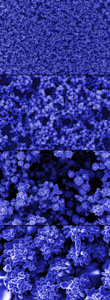Researchers have to position objects on appropriate substrates to enhance the emission of electromagnetic radiation using single molecules. Now, researchers at the Institute of Physical Chemistry of the Polish Academy of Sciences (IPC PAS) have devised a simple and cost-effective technique to create substrates for Surface Enhanced Raman Spectroscopy (SERS).
SERS is a tool used for research that improves the intensity of signals released by molecules by even millions of times. Associate professor at the institute, Dr Marcin Fia³kowski, says that to achieve such high enhancement of signals, the molecules must be positioned properly on a perfectly shaped substrate. When observed under an electron microscope, the substrates appear like peaked mountains. The peaks of signals are measured in nanometers, and the substrates are covered with a layer of gold.
 Electron microscope images showing substrates made of microflowers
Electron microscope images showing substrates made of microflowers
Currently, inexpensive, easy-to-use substrates are not available in the market for SERS analyses, which prevents the commercialization of the technique. However, substrates developed at the Institute of Physical Chemistry under the project, Quantum nanostructures will serve the above purpose. The substrates are formed on a slide surface as a result of deposition of spherical gold structures that precipitate from solution. These spheres measuring a few micrometers appear like flower buds made from several gold petals.
A SERS signal is highly enhanced when a molecule is positioned at the meeting point of the two substrate peaks. The effect cannot be achieved using previously established mountain-like surfaces, as the peaks are kept separated. However, when ragged microflowers deposit on the surface, they result in thick, complicated 3D formations with several meeting points between the petals, which is the reason why the signals released from substrates are intensified even by ten million times, says Katarzyna Winkler, a student from the IPC PAS.
Another important factor is the repeatability of signals gained from a particular substrate. On that count, the gold microflowers deliver superior performance. The signals arising from same type molecules placed at various regions on the same substrate are similar in nature. However, it is not always the same for surfaces processed using other techniques. Substrates created on different slides using separately prepared solutions render high signal repeatability.
The development of substrates with gold flowers is quick, simple and inexpensive. The gold flowers deposit within an hour and the substrate can be used on the next day.
The technique of depositing gold microflowers on surfaces designed for SERS applications is awaiting patents. Currently, the researchers are developing methods to clean analytes without disturbing the substrate structure.